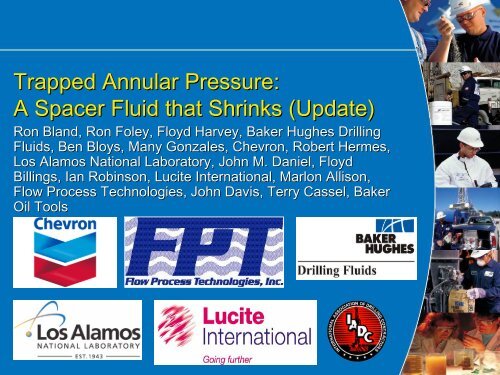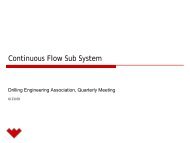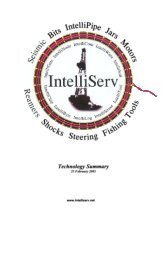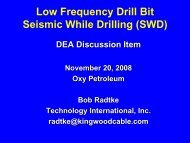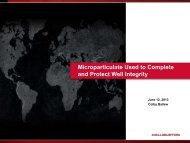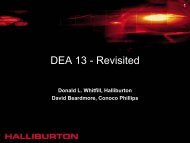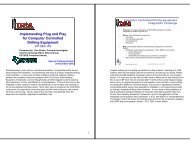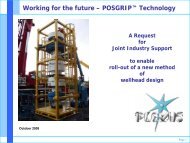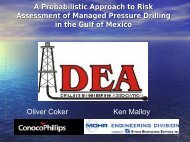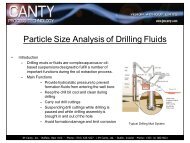You also want an ePaper? Increase the reach of your titles
YUMPU automatically turns print PDFs into web optimized ePapers that Google loves.
<strong>Trapped</strong> <strong>Annular</strong> <strong>Pressure</strong>:<br />
A Spacer Fluid that Shrinks (Update)<br />
Ron Bland, Ron Foley, Floyd Harvey, Baker Hughes Drilling<br />
Fluids, Ben Bloys, Many Gonzales, Chevron, Robert Hermes,<br />
Los Alamos National Laboratory, John M. Daniel, Floyd<br />
Billings, Ian Robinson, Lucite International, Marlon Allison,<br />
Flow Process Technologies, John Davis, Terry Cassel, Baker<br />
Oil Tools
What is <strong>Trapped</strong> <strong>Annular</strong> <strong>Pressure</strong>?<br />
(or <strong>Annular</strong> <strong>Pressure</strong> Buildup)<br />
•When cement is not<br />
circulated back to surface,<br />
drilling fluids or spacers<br />
become trapped in the<br />
annulus between the top of<br />
cement and the wellhead<br />
•Heat from produced oil/gas<br />
/water causes thermal<br />
expansion of these trapped<br />
annular fluids and can create<br />
more than enough pressure<br />
to collapse casing and tubing<br />
strings
From SPE 89775 - Pattillo, et al
What is <strong>Trapped</strong> <strong>Annular</strong> <strong>Pressure</strong>?<br />
• Mostly an issue in subsea<br />
completed wells<br />
• Previous mitigation techniques<br />
include VIT, heavy walled casing,<br />
nitrogen-based spacers, burst<br />
disks, crushable foam, leaving<br />
cement short of shoe, etc.
A New Approach<br />
• Cooperative research between Chevron and Los Alamos<br />
National Lab led to the development of a shrinking<br />
spacer based on methyl methacrylate (MMA)<br />
• MMA is a liquid monomer that polymerizes to form many<br />
familiar items like plastic windows and acrylic<br />
paperweights, and is the active ingredient in many latex<br />
paints<br />
• MMA shrinks 20% as it changes from emulsified liquid<br />
MMA droplets to tiny solid poly-MMA particles
<strong>Trapped</strong> <strong>Annular</strong> <strong>Pressure</strong><br />
Shrinking Spacer (TAPSS) Formulation<br />
• MMA is emulsified into a standard water-based spacer at<br />
10–50%<br />
•Water<br />
•Biopolymer (for viscosity)<br />
•Barite (1 st test – 12 ppg)<br />
•Emulsifiers<br />
•MMA (1 st test - 28%)<br />
•Defoamer<br />
•Inhibitor<br />
•Initiator (added as spacer is pumped)<br />
•Bicarb & caustic<br />
•Dispersant
TAPSS Preparation Overview<br />
MMA Monomer<br />
Initiator<br />
Solution<br />
Metering<br />
Mixer<br />
MMA/WBM Emulsion<br />
Transported<br />
to Wellsite<br />
Metering<br />
Mixer<br />
Pump<br />
Downhole<br />
Water-Based Mud
Mid-Scale Field Trial<br />
• Test site in Bossier City,<br />
LA had a 500-ft, cased well<br />
• Built an annulus from 7” 7<br />
and 9-5/89<br />
5/8” casing, with 3-3<br />
1/2” pipe within for hot<br />
water injection<br />
• <strong>Pressure</strong> tested
4500<br />
Test Results<br />
<strong>Trapped</strong> <strong>Annular</strong> <strong>Pressure</strong> Mitigation<br />
TAPSS vs. Standard Spacer<br />
4000<br />
3500<br />
Annulus <strong>Pressure</strong> - psi<br />
3000<br />
2500<br />
2000<br />
1500<br />
1000<br />
Polymerization begins<br />
Standard Spacer<br />
500<br />
TAPSS<br />
0<br />
0 20 40 60 80 100 120 140 160 180<br />
Minutes of Annulus Heating
TAPSS After Reaction<br />
Thicker, but still liquid with 28% Poly-MMA
Compatibility with Drilling Operations<br />
• Elastomers<br />
OK<br />
OK<br />
OK<br />
Buna ® (butadiene nitrile)<br />
Viton ® (fluoroelastomer)<br />
Urethanes<br />
• Contamination with Cement – OK<br />
• Contamination with KCl, NaCl or CaCl2 – OK<br />
• Contamination with SBM – OK<br />
• Contamination with standard cement spacer - OK
Off–Shore Procedure<br />
• Shipped to rig in closed-top, vented tanks<br />
• Tank(s) spotted on rig (watch wt. limits)<br />
• Mixed with initiator solution just before going<br />
down hole (initiator is a 5-7% feed)<br />
• Pumped down hole using cement unit, or<br />
similar<br />
• Should not mix with mud system, but 15%<br />
contamination in SBM only moderately reduces<br />
LC50
Safety Issues<br />
• Detailed risk analysis/mitigation process<br />
• Pure MMA has a low flash point - 55 º F, similar to<br />
methanol - only handled in mud plant<br />
• The emulsified spacer has an open cup flash point of<br />
175 º F<br />
• Fumes can accumulate in tank head space and<br />
become a risk (grounding)<br />
• Plan to use the pumping unit to flush water back<br />
through lines and pump skid to original tank
Safety Issues, cont.<br />
• Tank bottoms, wash water, etc. will be treated<br />
with a ‘hot’ initiator to eliminate any unreacted<br />
MMA<br />
• Proper PPE will be specified<br />
• Drips pans under all connections<br />
• Absorbents for small spills<br />
• Surfactants make the LC 50 low, as expected – so<br />
no offshore disposal
Detailed Operations & Safety Plans
Land Test – Carthage, TX<br />
• A quick land trial was held in a<br />
tubing annulus to provide a full<br />
scale test of:<br />
– Safety protocols<br />
– All mixing/metering equipment<br />
and manifolds<br />
– Pumping, and clean-up<br />
procedures<br />
– Initiator behavior
Spacer Mixing Skid<br />
• Meter in<br />
MMA<br />
• Emulsify in a<br />
single pass<br />
• Pump to<br />
transport<br />
tank<br />
MMA in<br />
High Shear<br />
Mixer<br />
Spacer to Tank<br />
Mud in
Manifold
Initiator Addition Skid (rig)<br />
• Meter in<br />
initiator<br />
solution<br />
• Mix well<br />
with spacer<br />
• Charge<br />
main<br />
pumping<br />
unit<br />
Mud in<br />
Initiator in<br />
Mixer<br />
Out to pump<br />
unit & well
Initiator Tank and Addition Skid
Wellhead <strong>Pressure</strong> vs. Time<br />
1200<br />
1000<br />
<strong>Pressure</strong> (psig) at manifold<br />
800<br />
600<br />
400<br />
200<br />
0<br />
0 10 20 30 40 50 60<br />
Time (minutes)
Polymerization vs. Depth<br />
% conversion of<br />
monomer to polymer<br />
120<br />
100<br />
80<br />
60<br />
40<br />
20<br />
0<br />
0 1000 2000 3000 4000 5000 6000 7000 8000<br />
Vertical Depth (feet)
Clean-Up Flushing Effective
Results<br />
• All fluids accurately mixed and well emulsified<br />
• Smooth displacement into well<br />
• <strong>Pressure</strong>d to 1000 psi<br />
• Shrinkage occurred as expected (sampled<br />
during well cleanout):<br />
– Bottom of well (240° F) – hotter than St. Malo<br />
production temperature – reacted quickly<br />
– Top of well – similar temperature to St. Malo<br />
annulus – virtually no reaction<br />
• All equipment cleaned by flushing with rinse<br />
water back to original tank<br />
• No HSE incidents
Preparing for a Deepwater Trial<br />
CVX producing properties - GOMBU<br />
Projects – CVX Op<br />
Projects – Non Op<br />
Discoveries – CVX Op<br />
Petronius<br />
Discoveries – Non Op<br />
Exploration Wells<br />
Gemini<br />
Tahiti #7<br />
10¾” tieback annulus<br />
Q2’09<br />
Tubular Bells<br />
Genesis<br />
Blind<br />
Faith<br />
Cat. Deep<br />
Tahiti<br />
Knotty Head<br />
Great White<br />
Tiger<br />
Tonga<br />
Puma<br />
Big Foot<br />
Discoverer<br />
Deep Seas<br />
Silvertip/Tobago<br />
Trident<br />
Jack<br />
St Malo<br />
Appraisal Projects
Planning a TAPSS Application:<br />
Determine the extent of the problem<br />
1. Model temperatures and pressures in trapped<br />
annulus<br />
– During seal formation<br />
– Maximum during flow testing/production<br />
– Geothermal and hydrostatic<br />
2. Compare the above with casing and seal<br />
assembly ratings to determine the minimum<br />
pressure reduction needed during flow<br />
testing/production to stay within casing/seal<br />
assembly ratings
Planning a TAPSS Application:<br />
Is TAPSS a feasible solution?<br />
3. Calculate fluid volume shrinkage needed at<br />
maximum flow test temperatures/pressures to<br />
achieve pressure reduction in ‘2. 2.’ above<br />
4. Using new fluid volume and pressures from ‘3. 3.’<br />
above, calculate shut-in pressures under<br />
geothermal conditions<br />
5. Are shut-in pressures using new fluid volume<br />
within casing/seal assembly ratings?<br />
6. If no, TAPSS may not be a feasible solution for<br />
well design/flow test schedule
Tieback Example with 16” Liner<br />
Example Deepwater Casing Diagram<br />
Drilling Schematic<br />
Well: Subsea Completion #1 Rig: BA Drillship #1<br />
Mudline Location:<br />
WBS No.<br />
API Well Number:<br />
BHL Location:<br />
Latitude/Longitude.:<br />
RT to MSL (ft): ±90'<br />
OBJECTIVES: Water Depth (ft): ±7000<br />
DIRECTIONAL: Straight Hole<br />
RT to ML (ft): ±7000'<br />
18-3/4" HPWH @ -16' 16' AML<br />
38" Housing @ -12' 12' AML<br />
EVAL GEOLOGIC MARKERS HOLE CASING MUD LOT<br />
PROG OBJECTIVES MD TVD SIZE & CEMENT MW OBG/FG<br />
±7400'<br />
16" LS @ ±7,400<br />
MWD/LWD t/ TD ±300' MD<br />
36" Jetted to ±300' BML<br />
±300' BML<br />
26" Hole<br />
TOS @ 8,509'<br />
8,509' BML<br />
±8800' MD<br />
' BML<br />
TVD<br />
±8800'<br />
10 3/4" X 9-7/8" CROSSOVER @ +/- 9,500'<br />
22" to ±8800'<br />
500' Tail, TOC @ Mud-line, 200% OHE<br />
±17000 MD<br />
TVD<br />
17,000'<br />
13-5/8" TOL @ < 17K'<br />
16"to ±17000'
Planning a TAPSS Application:<br />
Determine extent of pressure relief possible<br />
7. If yes, TAPSS may be a feasible solution and<br />
additional pressure relief may be possible<br />
– Try increasing pressure reduction in ‘A’ above<br />
– Recalculate fluid volume shrinkage required<br />
– Recalculate shut-in pressures under geothermal<br />
conditions using new volume<br />
– Compare with casing/seal assembly design<br />
ratings<br />
– Continue iterations until casing/seal assembly<br />
design ratings are reached
Planning a TAPSS Application:<br />
Determine Fluid Details<br />
8. Calculate trapped annulus volume capacity<br />
9. Adjust for other fluids planned for annulus<br />
10. Difference is maximum TAPSS volume possible<br />
11. What is the desired TAPSS density as pumped<br />
downhole?<br />
12. Calculate TAPSS density as shipped allowing<br />
for initiator dilution<br />
13. Determine maximum tank loading based on<br />
empty tank weight, TAPSS density & rig deck<br />
load limit<br />
14. Calculate number of tanks needed
Planning a TAPSS Application:<br />
What are rig constraints?<br />
15. Choose TAPSS staging area based on:<br />
– Space<br />
– Utility access<br />
– Deck load limit<br />
– Evacuation<br />
– Cement pump if pump is on top deck<br />
16. If cement pump on a lower deck a small HP<br />
pump will probably be needed such as a gravel<br />
pack pump
Thanks to:<br />
• Management of Chevron, Los Alamos<br />
National Laboratory, Baker Hughes Drilling<br />
Fluids, Baker Oil Tools, Flow Process<br />
Technology and Lucite International for<br />
permission to present this work.<br />
• IADC and the Programme Committee for<br />
accepting our abstract
Happiness is No <strong>Annular</strong> <strong>Pressure</strong><br />
Questions?


